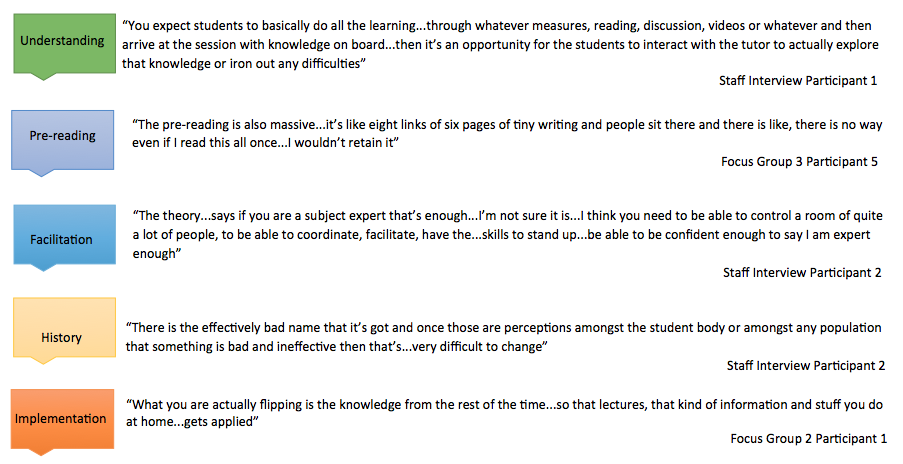



Theme
3BB The lecture and the flipped classroom
INSTITUTION
University of Dundee - United Kingdom
The term ‘Flipped Classroom’ has become more recognised and prevalent in medical education in recent years. Although ‘Flipped Classroom’ can take many forms the key feature is that no matter what type of teaching is adopted during the session, they all involve students gathering the relevant information outside of the classroom.[1] Therefore Staff and Students’ perceptions are important to determine if this is a teaching method, which should be implemented more in medical education. This qualitative case study explored both staff and student perceptions in one medical school in Scotland.
Three focus groups were carried out to explore Year 3 and 4 students’ perceptions of ‘Flipped Classroom’ teaching alongside semi-structured interviews to collect data from relevant teaching staff within the medical school. All data was anonymised before analysis and the research was approved by University of Dundee Research Ethics Committee.
Thematic analysis was carried out following transcription of all data collected, using the 6-phase framework devised by Braun and Clark.[2] This allowed matters within each case to be identified and the exploration of key themes.

The results demonstrated that students all spoke highly of this form of teaching when used as a tool to shape and consolidate knowledge they have previously learned via lectures or tutorials. [3] The main reasons for this was the relevant and manageable pre-reading assigned, along with facilitators who were experts in their field and both confident and comfortable with the classroom being ‘flipped’.
The history of ‘Flipped Classroom’ teaching at Dundee was the main contributor to the negative perceptions highlighted by both staff and students. ‘Flipped Classroom’ teaching lacked the key components described above when first introduced into the medical curriculum. There was also a lack of understanding of the concept as a whole which resulted in poor cooperation with pre-reading, which is detrimental to this form of teaching. Students argue, that content, length and accessibility of the pre-reading assigned at Dundee further contributed to this problem. Staff recognised that this way of teaching can be challenging for tutors and therefore stressed the importance of appropriate facilitation and training.
I.Students should be provided with teaching on this concept, outlining the educational benefits for them.
II. Pre-reading should be relevant in terms of content and length.
III. Training should be available for facilitators who are using this form of teaching.
IV. ‘Flipped classroom’ should be used increasingly where students have reported they find it most beneficial.
Dr. Fiona Muir, Senior Lecturer, University of Dundee
Dr. Susan Law, Honorary Senior Lecturer, University of Dundee
1.Berrett D. How “Flipping” the Classroom Can Improve the Traditional Lecture [Internet]. 2012 [cited 2014 Oct 14]. Available from: http://moodle.technion.ac.il/file.php/1298/Announce/How_Flipping_the_Classroom_Can_Improve_the_Traditional_Lecture.pdf
2. Braun, V. & Clarke, V., 2006. Using thematic analysis in psychology. Qualitative Research in Psychology, 3(2), pp.77–101. Available at: http://eprints.uwe.ac.uk/11735/2/thematic_analysis_revised... [Accessed July 11, 2014].
3.Sams, A. et al., 2014. What is Flipped Learning? The Flipped Learning Network (FLN). Available at: http://www.flippedlearning.org/cms/lib07/VA01923112/Centricity/Domain/46/FLI P_handout_FNL_Web.pdf [Accessed April 2, 2015].
 Send Email
Send Email